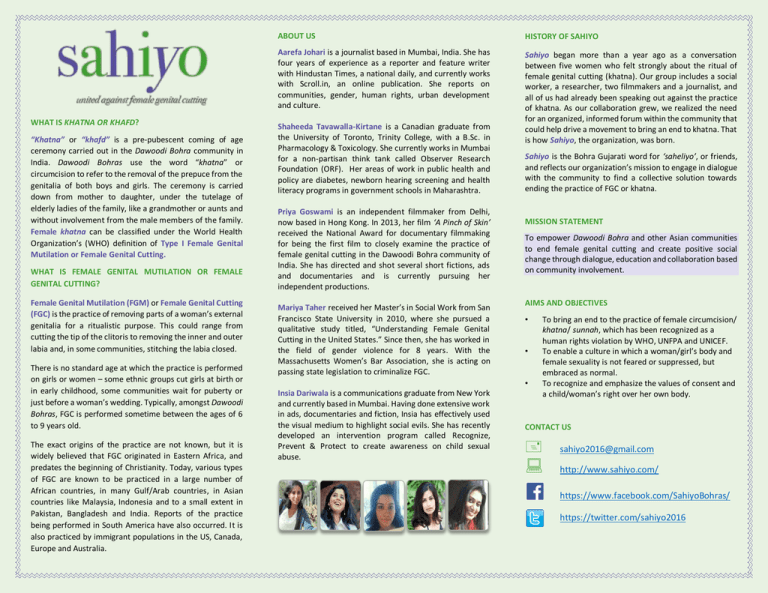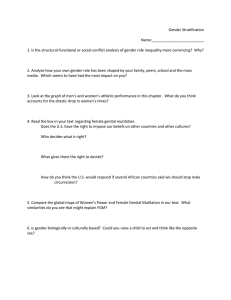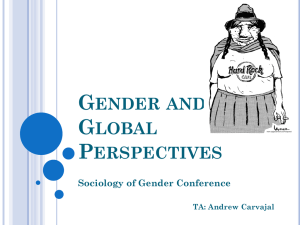http://www.sahiyo.com
advertisement

WHAT IS KHATNA OR KHAFD? “Khatna” or “khafd” is a pre-pubescent coming of age ceremony carried out in the Dawoodi Bohra community in India. Dawoodi Bohras use the word “khatna” or circumcision to refer to the removal of the prepuce from the genitalia of both boys and girls. The ceremony is carried down from mother to daughter, under the tutelage of elderly ladies of the family, like a grandmother or aunts and without involvement from the male members of the family. Female khatna can be classified under the World Health Organization’s (WHO) definition of Type I Female Genital Mutilation or Female Genital Cutting. WHAT IS FEMALE GENITAL MUTILATION OR FEMALE GENITAL CUTTING? Female Genital Mutilation (FGM) or Female Genital Cutting (FGC) is the practice of removing parts of a woman’s external genitalia for a ritualistic purpose. This could range from cutting the tip of the clitoris to removing the inner and outer labia and, in some communities, stitching the labia closed. There is no standard age at which the practice is performed on girls or women – some ethnic groups cut girls at birth or in early childhood, some communities wait for puberty or just before a woman’s wedding. Typically, amongst Dawoodi Bohras, FGC is performed sometime between the ages of 6 to 9 years old. The exact origins of the practice are not known, but it is widely believed that FGC originated in Eastern Africa, and predates the beginning of Christianity. Today, various types of FGC are known to be practiced in a large number of African countries, in many Gulf/Arab countries, in Asian countries like Malaysia, Indonesia and to a small extent in Pakistan, Bangladesh and India. Reports of the practice being performed in South America have also occurred. It is also practiced by immigrant populations in the US, Canada, Europe and Australia. ABOUT US HISTORY OF SAHIYO Aarefa Johari is a journalist based in Mumbai, India. She has four years of experience as a reporter and feature writer with Hindustan Times, a national daily, and currently works with Scroll.in, an online publication. She reports on communities, gender, human rights, urban development and culture. Sahiyo began more than a year ago as a conversation between five women who felt strongly about the ritual of female genital cutting (khatna). Our group includes a social worker, a researcher, two filmmakers and a journalist, and all of us had already been speaking out against the practice of khatna. As our collaboration grew, we realized the need for an organized, informed forum within the community that could help drive a movement to bring an end to khatna. That is how Sahiyo, the organization, was born. Shaheeda Tavawalla-Kirtane is a Canadian graduate from the University of Toronto, Trinity College, with a B.Sc. in Pharmacology & Toxicology. She currently works in Mumbai for a non-partisan think tank called Observer Research Foundation (ORF). Her areas of work in public health and policy are diabetes, newborn hearing screening and health literacy programs in government schools in Maharashtra. Priya Goswami is an independent filmmaker from Delhi, now based in Hong Kong. In 2013, her film ‘A Pinch of Skin’ received the National Award for documentary filmmaking for being the first film to closely examine the practice of female genital cutting in the Dawoodi Bohra community of India. She has directed and shot several short fictions, ads and documentaries and is currently pursuing her independent productions. Mariya Taher received her Master’s in Social Work from San Francisco State University in 2010, where she pursued a qualitative study titled, “Understanding Female Genital Cutting in the United States.” Since then, she has worked in the field of gender violence for 8 years. With the Massachusetts Women’s Bar Association, she is acting on passing state legislation to criminalize FGC. Sahiyo is the Bohra Gujarati word for ‘saheliyo’, or friends, and reflects our organization’s mission to engage in dialogue with the community to find a collective solution towards ending the practice of FGC or khatna. MISSION STATEMENT To empower Dawoodi Bohra and other Asian communities to end female genital cutting and create positive social change through dialogue, education and collaboration based on community involvement. AIMS AND OBJECTIVES • • • Insia Dariwala is a communications graduate from New York and currently based in Mumbai. Having done extensive work in ads, documentaries and fiction, Insia has effectively used the visual medium to highlight social evils. She has recently developed an intervention program called Recognize, Prevent & Protect to create awareness on child sexual abuse. To bring an end to the practice of female circumcision/ khatna/ sunnah, which has been recognized as a human rights violation by WHO, UNFPA and UNICEF. To enable a culture in which a woman/girl’s body and female sexuality is not feared or suppressed, but embraced as normal. To recognize and emphasize the values of consent and a child/woman’s right over her own body. CONTACT US sahiyo2016@gmail.com http://www.sahiyo.com/ https://www.facebook.com/SahiyoBohras/ https://twitter.com/sahiyo2016 WHO ARE THE DAWOODI BOHRAS? The Dawoodi Bohra (DB) sub-sect is also known as the Western Ismailis of India, and they form a large, rich and flourishing ethno-religious trading community of about 1.5 million strong across the world. The sect adopted Islam from Egypt, spread to Yemen and trace their ancestry to early conversion to Ismaili Shi’ism during the reign of the Fatimid Caliph – Imam al Mustansir. HOW DOES THE WORLD HEALTH ORGANIZATIONS CLASSIFY FGC? The World Health Organization classifies FGM as a violation of the human rights of girls and women. According to WHO, FGM reflects deep-rooted inequality between the sexes, and constitutes an extreme form of discrimination against women. It is nearly always carried out on minors and is a violation of the rights of children. Type of FGC Type 1 (Clitoridectomy) Type 2 (Excision) Type 3 (Infibulation) Type 4 (All other forms) The DBs are governed by the Fatimid School of Muslim Law. In or around the 16th century, the DBs travelled from Yemen and landed on the Western coastal regions of India, from where they spread to the rest of India. In addition to the local languages, the main language of the DB community is ‘Lisan al-Dawat’, a unique dialect of Gujarati with inclusions from Arabic, Urdu and other languages. The script used is Perso-Arabic. SOME UNIQUE FEATURES OF DAWOODI BOHRAS • • • • • They maintain a very distinct form of attire, and even have their own unique cuisine. The DBs are a closed group with a strong sense of community consciousness and religious identity, which they jealously protect and guard. They are a highly organized sect with a centralized hierarchical clergy known as the ‘dawat’. The spiritual head of the DB is the Dai-ul-Mutlaq also called the ‘Dai’, and sometimes referred by honorific terms like ‘Maulana’, ‘Aquamola’ or ‘Syedna’. The seat of the religious priesthood is in India and the Dai lives in Mumbai. The DB are primarily a mercantile community and claim 100% literacy in the community. Both men and women are well-educated and enterprising, and many are successful traders, businessmen and professionals like doctors, teachers and lawyers. Definition The cutting of the clitoral hood or prepuce, or the partial or complete cutting of the clitoris. The partial or total removal of the inner labia, which could include removal of the clitoris and a part of the outer labia. The cutting away the inner and/or outer labia, which may or may not include the clitoris, and then sewing up the wound to leave just a small hole for urinating and menstruating. Includes all other harmful practices performed on a woman’s genitalia, such as piercing, incising, burning the genitals or even inserting substances into the vagina to tighten it. HOW IS KHATNA CARRIED OUT AND WHO PERFORMS IT? Khatna is performed by a traditional cutter also known as a ‘mulaani’ with rudimentary equipment like a disposable blade under non-sterile conditions and in a household setting. Although DBs claim to only remove the prepuce, many women have had either a part or all of the clitoris cut, while others have suffered extensive bleeding and other complications due to botched procedures by untrained and uneducated cutters, who have no knowledge of medical sciences or anatomy. Due to concerns of hygiene and safety, girls are now taken to hospitals or medical clinics for the procedure to be performed, particularly in the bigger cities. This is known as the ‘medicalization of female genital cutting’, and it is a hotly debated medical ethics issue. Trained health professionals who perform female genital mutilation are violating girls’ and women’s right to life, right to physical integrity and right to health. They are also violating the fundamental medical pledge to ‘DO NO HARM’. WHAT ARE THE HEALTH CONSEQUENCES OF FGC? The WHO reports that an estimated 90% of cases include Types I, Type II or Type IV FGC (“nicking” without flesh removal) and about 10% are Type III (most severe). Besides the possible physical consequences of Type I FGC like infections, excessive bleeding, burning sensation while urinating etc., it is vital to note that the practice can have a negative impact on mental health. The personal betrayal associated with khatna comes from the fact that a child is typically taken for the procedure under a misleading pretext, making her partially undress and inflicting pain in a sensitive part of the body with little or no explanation. Many circumcised women remember resisting the blade in fear. It is an act that induces trauma for many children and even if the trauma is forgotten by the conscious mind, it can surface later in life, like at the time of marriage and one’s first sexual experiences, manifesting in the form of fear of sexual intimacy and aversion to the act of sex. WHAT DOES ISLAM SAY ABOUT FGC? The Qur’an does not talk about male or female circumcision, but male circumcision is considered mandatory in Islam – it is seen as one of the five “sunnah-al-fitrah” (obligatory customs of nature) that Prophet Mohammed preached: circumcision, cutting the nails, trimming the moustache, plucking pubic and armpit hair. FGC, on the other hand, is not considered obligatory, but, according to a section of Islamic scholars, it is prescribed. There is a reference to female circumcision in several ‘hadiths’. However, some scholars, particularly from Cairo’s Al-Azhar University – one of the most respected universities in the Islamic World – consider these to be poor in authenticity and open to interpretation; they have, therefore, denounced the practice as not being necessary under the umbrella of Islam. Dawoodi Bohras primarily use a text called ‘Daim al-Islam’ to endorse khatna for women for reasons of hygiene and purity (‘taharat’). Other reasons community members cite include religious dictate, to reduce excessive sexual desire and to curb ‘hawas’, to discourage promiscuity and masturbation, to enhance a woman’s sexual pleasure, to increase marriageability and because it is a part of tradition. HOW IS KHATNA DIFFERENT FROM MALE CIRCUMCISION? Dawoodi Bohras perceive the removing of the clitoral hood to be the female equivalent of cutting the male foreskin; both procedures are performed at an age when children are not old enough to give consent. Although male circumcision is also a topic of intense debate, WHO has stated that there is compelling evidence to show medical benefits of the procedure. In comparison, FGC has no medical benefits and is used to curb sexual desire. Male circumcision is also not linked to a man’s sexual desire or pleasure, and does not affect the sex organ. FGC damages the sex organ, inhibiting pleasure, and potentially causing severe pain and complications for women’s sexual and reproductive health.


